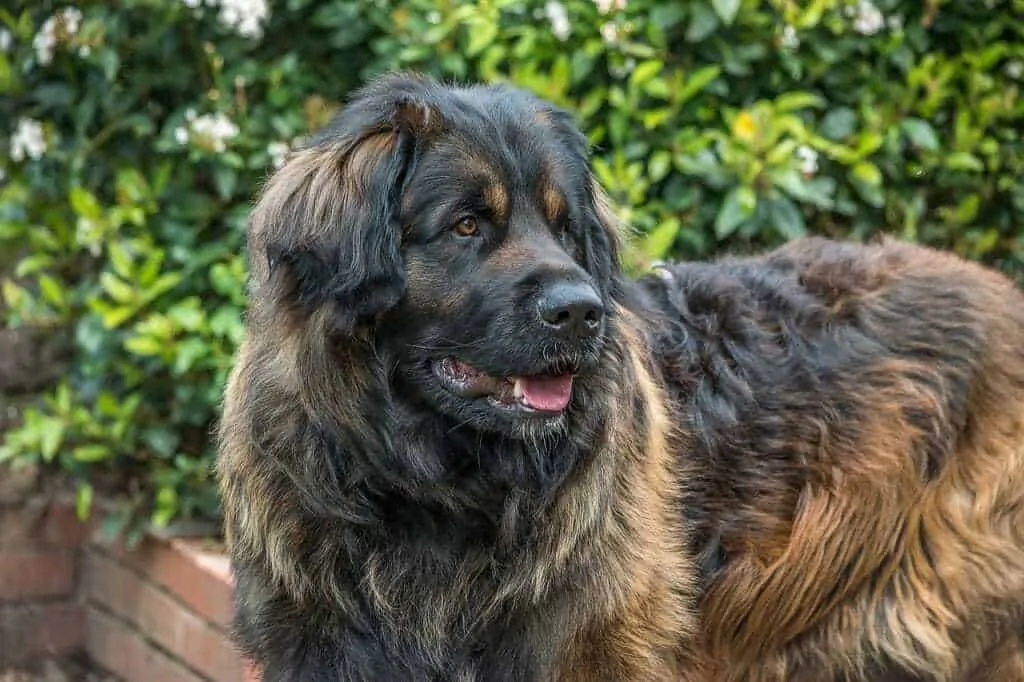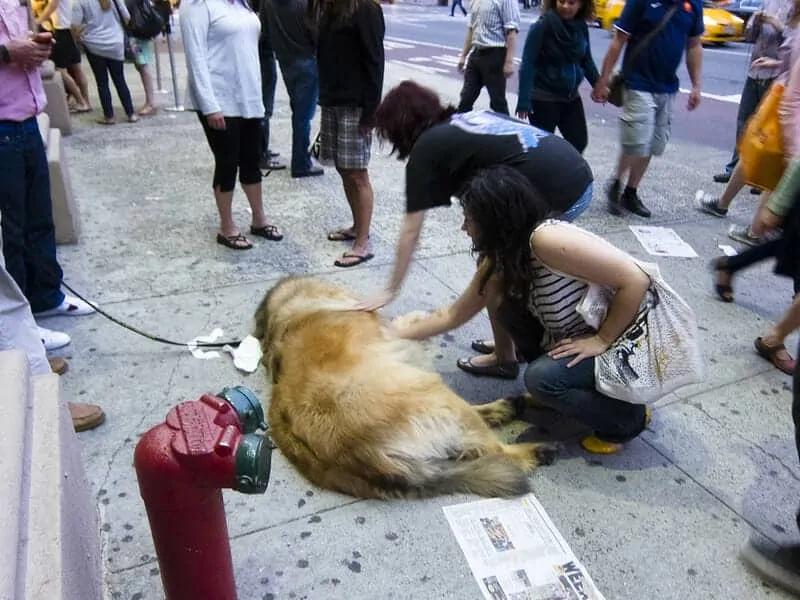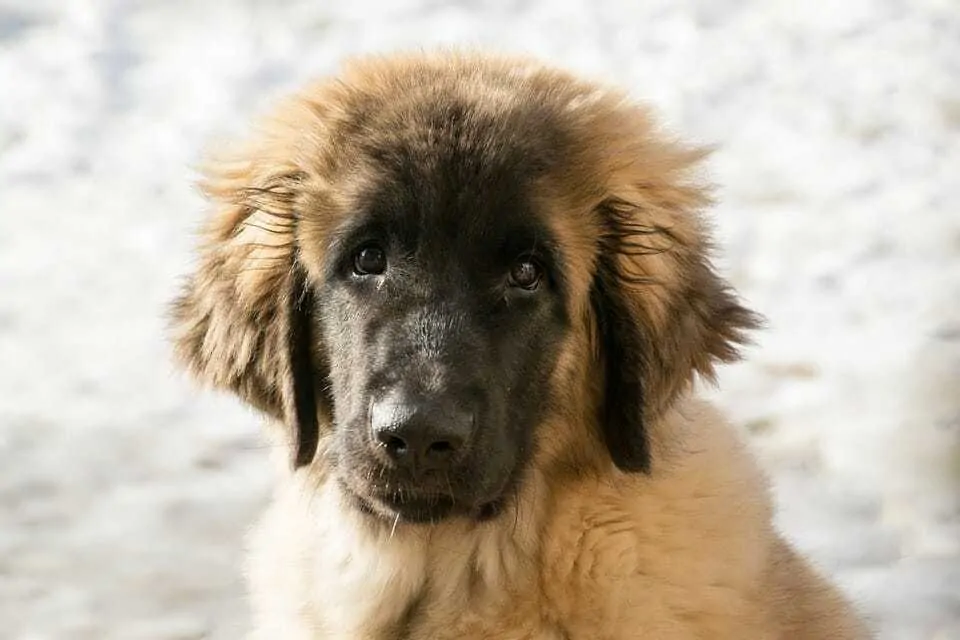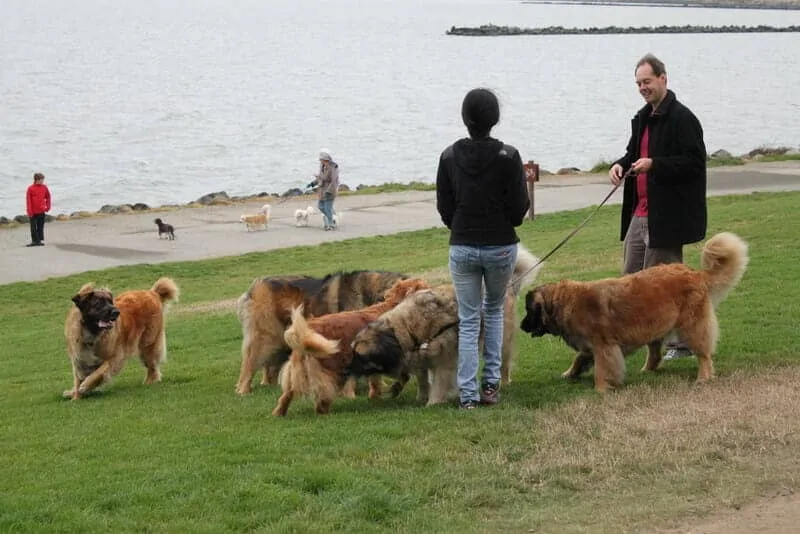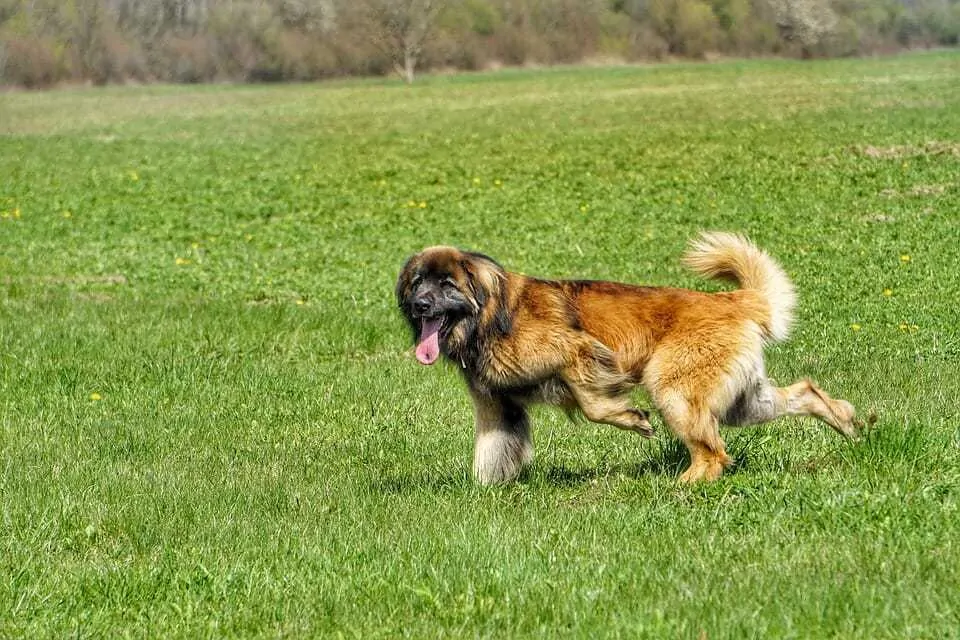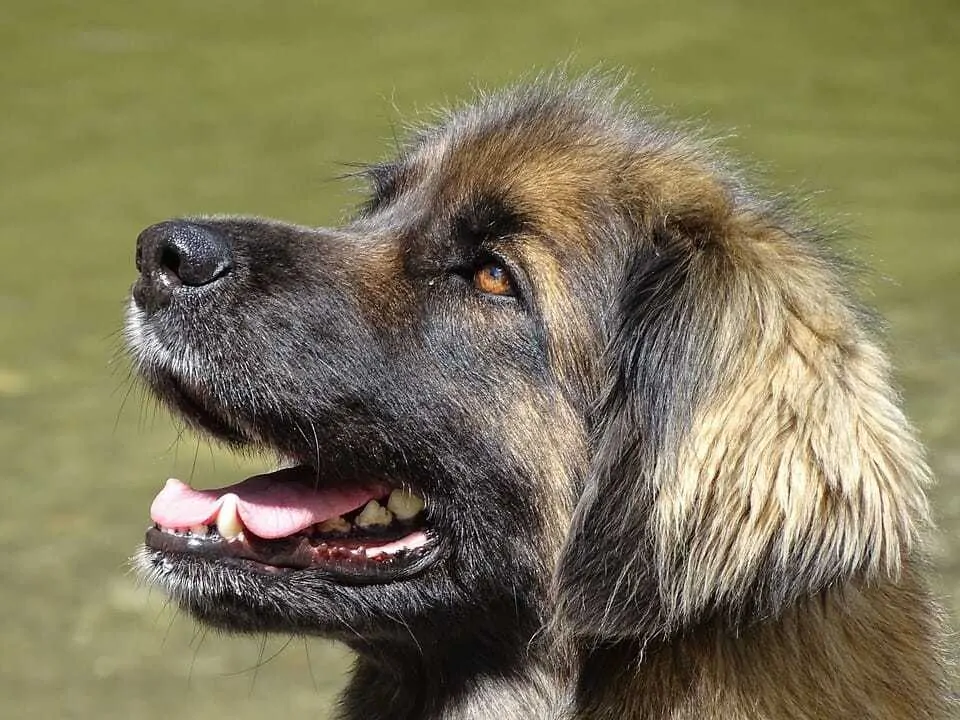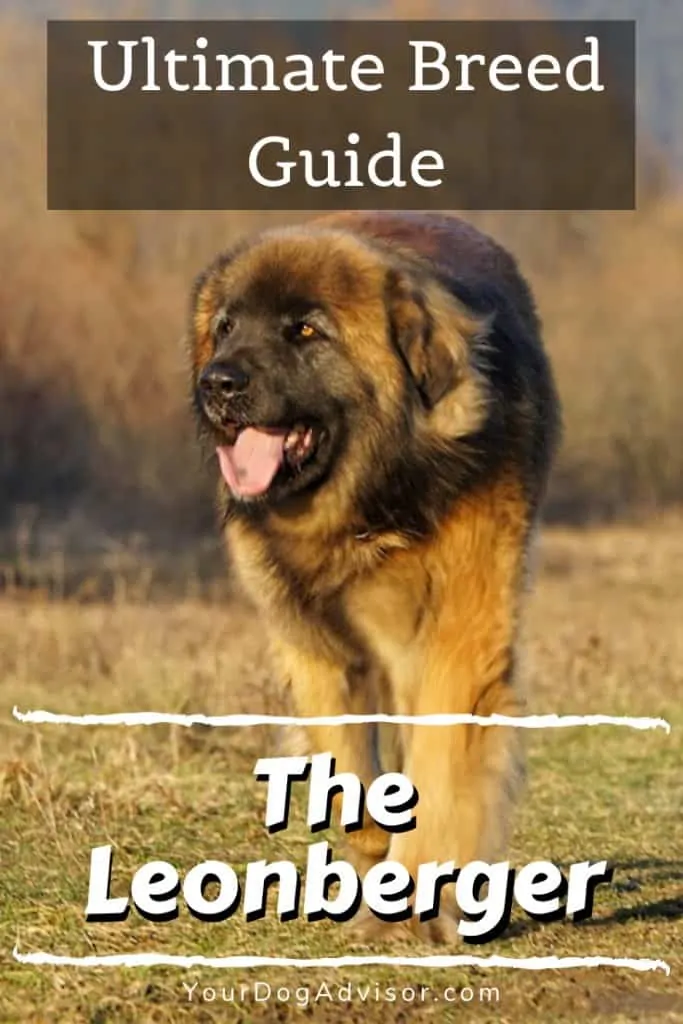This gentle giant may look like they were bred for the battlefield, but their history is not at all what you’d expect. Their personality, however, is much more straight forward. The Leonberger is a calm and devoted companion, perfect for families. But they also require a lot of space, early training and socialization, and an owner with the time or means to care for that elegant lion-like coat.
Keep reading to find out if you have what it takes to own one of these royal canines.
Contents
General Characteristics of the Leonberger
- Other names: Leo
- Height: 25.5 to 31.5 inches with females being shorter than males
- Weight: 90 to 170 pounds with females being much lighter than males
- Lifespan: 9 years
- Origin: Germany
- Colors: Lion-yellow, gold, sand, red, red-brown, or any combination thereof, always with a black mask.
- Activity level: Low to moderate
- Grooming needs: High
- Best suited for: Owners and families with a lot of space
The Leonberger may look intimidating, but this giant breed is much more likely to jump in your lap for some cuddles than to act aggressively.
The History of the Leonberger
The history of the Leo is somehow simultaneously complex and oddly simple.
The breed was created by a man named Heinrich Essig who lived in Leonberg, Germany, in the early 1800s. But Essig’s goal wasn’t to create the ultimate working dog. His sights were set much higher. He wanted to craft a breed that would appeal to the wealthiest families of Europe. A companion animal that was majestic and awe-inspiring, but easy to keep and gentle with family.
He turned to the popular large mountain breeds of the time and crossed a Landseer Newfoundland, a St. Bernard, and eventually a great Pyrenees. The resulting dog was both powerful and warm and, with the male’s large mane and oversized head, somewhat resembled the lion on the Leonberg coat-of-arms.
Essig, who was a politician and entrepreneur with a passion for breeding and selling dogs, used his marketing skills and connections to build the breed’s popularity around Europe. Before the end of the century, the lion-dog could be found in royal houses in Wales, France, Italy, Russia, and Austria.
While they were not originally bred to work in any particular field, the Leonberger had a number of natural talents that grew their popularity in the working class as well. They were often utilized as guard dogs as well as cart pullers. Their intelligence, instinct for rescue, and strength in the water made them natural open water rescue dogs. This talent eventually brought them overseas to Canada where they have been used alongside Newfies and Labradors in search and rescue.
Because they were originally bred for the sole purpose of providing companionship to the wealthy and affluent, the Leonberger is a very tolerant, confident, and gentle dog. They don’t typically mind loud noises, crowds, or being mobbed by their adoring fans. “Leonberger on Second Ave” by Dan Nguyen / CC BY-NC 2.0
The original Leonberger was white, a color that was popular among the nobility at the time. But, after two world wars severely reduced the Leos numbers, the breed was further bred with St. Bernards creating the tawny dog with a black muzzle that we have today.
While they may not hold the royal status they once did, the Leo of the modern era is still prized as a gentle family dog and majestic companion.
The Temperament of the Leonberger
The Leo may have been created in the image of the lion, but their temperament is anything but fierce. Much like the gentle giants that went into making this breed, these dogs are prized for their friendly personalities, confident demeanor, and stoic nature.
A Leo is neither shy nor aggressive. They are typically gentle with family and friendly with strangers, so long as they do not appear threatening. They are observant and intelligent and make great watch dogs, though they are less likely to act aggressively toward trespassers than a true guard breed.
The Leonberger may start out small, but they grow fast. Early training, socialization, and plenty of activity is key to making it through these large dogs’ active adolescent phase and into a more peaceful adulthood.
Adolescent Leos are energetic and playful. They need a lot of socialization early on to ensure their easy confidence extends to all situations outside the house. They also do well when given a job that will occupy their mind and give them an outlet for their energy. Once a Leo is full-grown, they are great candidates for a number of activities, including agility, dock jumping, hiking, and jogging. But what they truly excel at is cart pulling and other dog sports that show off their raw power.
Adult Leos tend to be much calmer and only require moderate exercise each day. A long jog or active playtime in the backyard is usually all they’ll need before spending the rest of the day lounging about.
Still, these are very large dogs that like a lot of space. They prefer houses with yards to roam and plenty of time spent exploring outdoors.
Leos are not nearly as stubborn or independent as other mountain breeds. They like to please their owners and have the intelligence to learn quickly. However, it is necessary to set up a consistent training routine early to avoid a misbehaving 170-pound giant later on.
Overall, these massive dogs are gentle, dependable, and calm. They need their space and require daily exercise but are generally happy to sleep the day away. Younger dogs need more activity and plenty of socialization and training.
Want to learn more about what makes the Leonberger tick? Check out this video.
Health Issues Common to the Leonberger Breed
The Leo is a fairly young breed that has seen multiple episodes of population decline in their short existence. For this reason, there are a number of genetic issues known to plague the breed as well as some common giant dog problems to be aware of.
Here are some health issues to familiarize yourself with before purchasing a Leo puppy.
- Digestive problems
- Heart problems
- Entropion
- Cataracts
- Progressive retinal atrophy
- Thyroid disorders
- Hip dysplasia
- Paralysis/polyneuropathy
- Cancer
- Bloat
Due largely to the dedication of national and international breed groups, many of the Leo’s inherited disorders are becoming less common.
A consolidated effort to not breed any dog with hip dysplasia or relatives with the condition led to a huge decrease in the frequency of the condition in the breed. In fact, among giant breeds, they suffer from this problem far less frequently than others.
Leonberger owners tend to be a passionate bunch, often organizing Leo get-togethers and playdates. These dedicated people are one of these reasons this breed still exists today despite multiple episodes of drastic population decline over the last century. “Leonbergers and Friends” by Mo Pie / CC BY-NC-ND 2.0
Genetic testing has also helped reduce the appearance of polyneuropathy and other neurological disorders.
Unfortunately, many of these stricter rules enforced by the Leonberger Club of American have been largely negated since they joined with the AKC in 2010. However, it is still possible to reduce your risk of getting a Leo with severe health problems by researching your breeder and only buying from reputable sellers who still adhere to the stricter breeding rules.
Some health issues like bloat and joint problems are not entirely genetic. To make sure your dog has the best chance at a long life, you will need to take steps to protect them.
Large breed dogs with deep chests, like the Leo, are prone to bloat. To avoid this fatal condition, always make sure to allow your dog time to rest after eating. It is also a good idea to portion out their meals to avoid them eating too much food at once and always place their bowl on the ground, never an elevated feeder.
Leo puppies need to be fed a large-breed specific puppy food to control their growth rate. Feeding a normal puppy diet may lead to their joints growing too fast, which can lead to dysplasia and arthritis down the road.
If the thought of buying a puppy with unknown health issues sounds like a lot, you may want to consider rescuing a Leo. While these dogs are not overly popular, their large size often makes them difficult to keep in the wrong situation which is how many Leos end up looking for a new home. Contact your local Leo or big dog rescue today for the opportunity to save the life of one of these majestic giants.
Adult Leonbergers tend to be calm dogs, but they still enjoy their space. A romp in a large backyard or a hike through the forest will keep your Leo happy well into their golden years.
Do Leonbergers Do Well With Children and Other Pets?
One characteristic Essig knew he had to breed into the Leo if it were going to be popular with noble families was a child-friendly personality. After all, these dogs were to be used as companion animals, not working canines.
In this endeavor, he was very successful. The Leo is a gentle, tolerant dog with a fondness for babies and children. They have the size to tolerate even the roughest of play and a natural nurturing quality thanks to the livestock guardians in their ancestry.
That said, these dogs are incredibly large and powerful, so all dog-child interactions should be supervised. It is also important to socialize puppies with children of all ages to assure they grow up confident and happy around them.
In general, Leos enjoy the company of other dogs. Young Leos, especially, are very playful and have a lot of energy to burn. Having another young dog of similar size to wrestle with is a great way to assure that energy is used in a positive way. As Leonbergers age, they tend to be less energetic but will still enjoy the company of other canines.
>>>Want to get your new puppy started out on the right paw? Here are 10 things to do with your pup in the first 10 days.
Leos don’t have any natural prey drive and typically are trustworthy around cats and other small pets. Of course, your best assurance for a peaceful household is to socialize your Leo with all types of animals early on.
It is said that the Leonberger can read human emotions. These dogs will often cower or hide during family arguments and are usually the first to comfort their owners when they are feeling blue. This is just one of the reasons they make such great companions for children.
What to Consider Before Bringing Home a Leonberger
Think a Leo is the right dog to add to your family? Here are a few more things to consider before pulling the trigger.
Activity Level
Young Leos have a lot of energy, which can be problematic in a dog that can easily reach 100 pounds before their first birthday. Plan on enrolling your new pup in training classes right away. Once they hit adolescence, they’ll be much happier if they have a job to do. Whether that job is romping alongside you on your morning run or pulling carts competitively doesn’t really matter so long as it keeps them from getting bored.
Older Leos tend to be calmer. They will enjoy playtime in the yard and long walks but are otherwise happy to lounge at your feet while you watch TV.
Trainability
These dogs are very smart and like to please their people. They can be submissive around family and need a respectful, patient, and kind owner to help build their confidence during training. Too much force will result in a dog that shuts down when commands are given.
Along with early training, these dogs should be socialized with people of all ages and animals of all types. Their nature is to be calm and confident, but any undersocialized dog can react negatively in a new situation. And a powerful giant like the Leo can easily cause problems. But, with the right socialization as a puppy, an adult Leo has the right personality to be taken just about anywhere. They are especially well suited to be therapy dogs.
Don’t let that puppy coat fool you, Leonbergers have a thick double coat that requires a lot of time and effort to manage. They are also prolific shedders, so make sure your vacuum is up to the challenge before committing to one of these fuzzy giants.
Grooming
When it comes to grooming, the Leo demands a lot of attention. Their thick double coat is comprised of a coarse, waterproof outer layer and a soft, insulating bottom coat. The coat is meant to be kept in its natural state with the exception of clean up around the feet. But, to avoid matting, you will need to brush your dog out at least a couple of times a week.
Bathing a dog this size with a coat this thick in your bathtub can be tricky, not to mention, messy. And, since the coat is more likely to mat if not well-dried, your best bet is to take your Leo to a professional groomer to be bathed. Depending on how often your dog plays outdoors, this can mean a trip to the groomers every month.
Nutrition
These dogs will do well on any quality diet assuming it has enough protein and the right fat profile to support their large size and a slower metabolism. Puppies require a large-breed puppy specific diet until they are full grown.
Diets high in quality animal products and free from chemical additives will help support coat health and reduce the odds of skin allergy problems.
Cost
Getting a purebred Leo will cost you around $2,000 for the average companion pup.
>>>Found out how much it actually costs to own a dog.
These are shorter-lived dogs that can suffer from a number of health issues, especially as they age. They also require a lot of food so be prepared to spend more on your Leo than the average dog owner.
The original Leonbergers were white or light cream in color, much like the great Pyrenees. The classic black mask and tawny coloring didn’t appear until much more recently.
10 Fun Facts About the Leonberger
Now that you know what it takes to own a Leo, here are some fun facts about the breed.
- All Leonbergers alive today can trace their lineage back to the 8 dogs that survived World War II.
- Males and females are dimorphic and easily distinguishable as the females are smaller and the males have larger heads and manes.
- After World War I, only 5 breeding Leos were recovered. After four years of selective breeding, over 350 more were produced.
- The Leo almost went extinct in America during the great depression and the breed wasn’t reintroduced in large numbers until the 1970s.
- There are some Leo experts who believe a Leonberger-type dog existed in Germany before Essig and that the man merely added to the breed and gave it an official name.
- Leos are strong swimmers, have webbed feet, and a waterproof coat.
- They shed almost constantly with more intense shedding periods twice a year.
- While Heinrich Essig gets the credit for creating the breed, it was his niece, Marie, who did most of the breeding and kennel maintenance while he promoted the breed around the world.
- They have relatively small litters for their size, with only about 6 puppies on average, though, one record-breaking female had 18 pups in one litter.
- Leos have been used to track missing persons as well as for water rescues.
Before You Go
Not sure you have what it takes to care for one of these furry giants? Here are some more breeds worth considering.

Sara Seitz has spent most of her life in the pet industry and has a bachelors in animal behavior from Colorado State University. Sara started working with dogs and cats as a high schooler at a rural boarding kennel. There she learned a lot about the bad and the ugly of the pet service industry. But not even the toughest day at that job would dissuade Sara from following her dream of working with animals.
In college, Sara got a job at a dog daycare and boarding facility in Fort Collins, Colorado. Her new career provided even more opportunities for learning about dog behavior than her classes did. As general manager of the daycare, Sara helped the company launch a new in-home pet sitting branch and trained to become a certified dog trainer. Between shifts taking care of peoples pets in-home and supervising dogs during playtime at the daycare, Sara organized and taught obedience classes.
Sara has always been passionate about bettering the lives of our canine companions. She soon found that advocating for and educating owners in the power of positive reinforcement training was one of the best ways to help dogs and their owners live happier lives.
